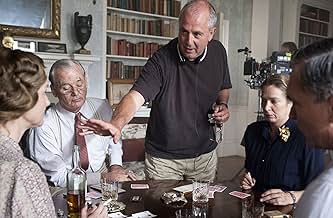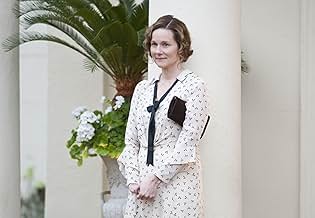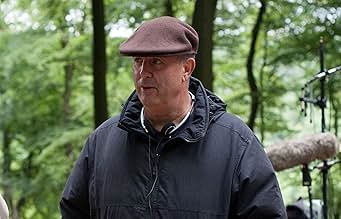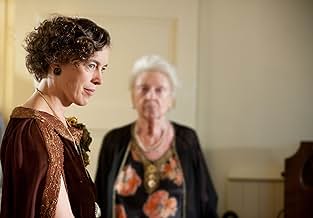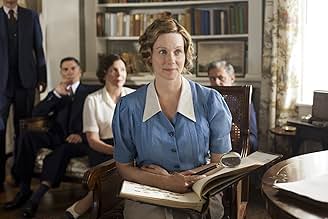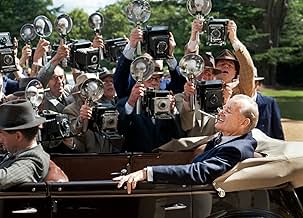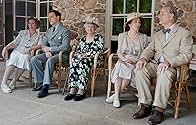A história do caso de amor entre FDR e sua prima distante Margaret "Daisy" Suckley, centrada no fim de semana de 1939, quando o Rei e a Rainha do Reino Unido visitaram o estado de Nova York.A história do caso de amor entre FDR e sua prima distante Margaret "Daisy" Suckley, centrada no fim de semana de 1939, quando o Rei e a Rainha do Reino Unido visitaram o estado de Nova York.A história do caso de amor entre FDR e sua prima distante Margaret "Daisy" Suckley, centrada no fim de semana de 1939, quando o Rei e a Rainha do Reino Unido visitaram o estado de Nova York.
- Prêmios
- 1 vitória e 5 indicações no total
Avaliações em destaque
It's a few years before The Big One, WWII, but there's a storm a-brewing in Europe. Everyone knows it, but relations between the U.S. and England have been strained, something about revolting and then fighting in the War of 1812. Ancient history to some but not all, it would seem. At any rate, King George VI and Queen Consort Elizabeth (Samuel West and Olivia Coleman, respectively) travel to America to visit Roosevelt with the intention of securing his support for the upcoming war. But rather than host them in stuffy Washington, DC, FDR (contrary to the real visit) invites his royal guests to his home away from home, Springwood, a stately manor in upstate New York. It happens to be on the Hudson River, or near it, in case the title has tripped you up.
Now, FDR was quite an unusual president. He was the last to serve more than two terms, as the Constitution was amended later. Also, he had polio, which he had contracted as a child. The funny thing is this - people went to great lengths to pretend nothing was wrong with Roosevelt's legs whatsoever. The Emperor had no clothes. Even the press were complicit, gamely waiting for the president to be lowered into the back of a convertible before taking their pictures and asking their questions. Can you imagine that today? The slightest limp by a leader seems to imply a lack of leadership in the minds of some.
And so it was at the time, only not. The nation turned its eyes to Roosevelt as a resolute, optimistic leader, a man who could help them finally rid themselves of that awful Depression, and so they gladly ignore whatever shortcomings he may have. The king of England, meanwhile, is in a similar situation. He is the same George depicted in The King's Speech - you know, the one about the king who stuttered? FDR, who is much older, is not as self conscious about his malady as he used to be, whereas poor George is practically frozen by his own. Now, recall that the king and queen are visiting to gain the support of America; FDR already knows this. He could easily just issue a statement to the effect that the USA would help England in any way it could, but he chooses to host royalty instead. He wishes to meet the man beneath the crown, and he wishes to size him up.
Enter into the fray a quite-distant cousin of FDR, a Daisy Stuckley (Linney), who narrates the story. Daisy is introduced to the president, and somehow they find a connection. Daisy, like the arriving king, is also unsure of herself, a bit of an ugly duckling among the glamor of the president's residence. They find in each other a kindred spirit. Franklin is more or less estranged from his saintly wife Eleanor at this point (they live in separate houses in New York!), and although he cannot walk, he does enjoy him some female company.
But what is this story really about, anyway? It depends on your own perspective. Some will see this as a docudrama reflecting the meeting of two leaders (and their wives); some will see it as a comedy, an intelligent, subtle comedy with a barely smirking Bill Murray. Others still will find romance in almost every scene, no matter who the players, no matter where the setting.
Murray deserves an Oscar nomination here, and perhaps the Academy will make up for their Lost in Translation snub. Linney does as well; her Daisy never undergoes a sudden transformation into a woman with a real backbone. She seems sad much of the time, working in the White House with tightened lips. Her life appears joyless; that is, until she has some alone time with Franklin, whence a window to a sunnier day slowly opens.
Hyde Park on Hudson is a gorgeous movie with a splendid, bemused, and convincing performance by Bill Murray as our 32nd president and endearing, exhilarating role for Laura Linney. Each should be richly rewarded come award time.
In 2004 he was honored with his first Academy Award nomination for his outstanding performance in Lost In Translation for which he was visibly disappointed that he was the recipient. 9 years later he just may be poised for his second Oscar nomination for his unbelievable portrayal of former president Franklin D. Roosevelt. A most unlikely choice on the film maker behalf, but one that will prove to be a proud choice. The film is Hyde Park On Hudson with whom he co-stars along side the always great Laura Linney.
The story is one of an affair the president had with an extremely distant cousin that carried on for years when he would retreat to Hyde Park, NY of which he was quite fond of doing much of his work from there. During the early stages of the affair a monumental occasion occurred when the new king of England became the first king to visit American soil in history. King George VI affectionately known as Bertie, who was recently portrayed by Academy Award winner Colin Firth in The Kings Speech, was very new to his position and felt it best to visit the US and the president to keep up relations. Over a weekend in Hyde Park the king and president formed a very special relationship that proved vital as WWII would shortly break out a few weeks later.
What is most intriguing was that you had to fine men in positions of great power that at the same time had great flaws, Bertie with his stutter and Roosevelt with his partial paralysis. The film has a fine moment when the two converse late one night and the president clearly seems to instill a great confidence in the king when they both realize many similarities in each other.
Over the same weekend the president's affair with his cousin, Daisy quickly becomes threatened and almost comes to a complete halt.
The film is a fine story and well told but it's not without rhythmic issues and has several slow moments. It is without question carried on the shoulders of Murray's performance. It's not a story that has you drawn in within seconds and has some difficulty keeping you there. It is though a good movie that deserves to be soon for Murray alone.
Murray shows the often unknown and unseen humorous side the president Roosevelt and does it with great perfection. His portrayal is one of the great performances of a historical figure in recent years. The one flaw in his award chances may be he happens to be against another fine actor playing an iconic president in Daniel Day-Lewis in Lincoln. It's a story every years where a deserving actor comes away empty handed because someone just happens to be on another level.
Murray's day will come at some point. His commitment to taking great roles and being someone different every time only proves that. Unfortunately we will have to wait a little longer. Loveyourmovies.com
Mostly confined to a wheelchair and married to a woman he did not love, Roosevelt reportedly had affairs. The film focuses on one such affair that started just before the King and Queen of England were to arrive. Margaret "Daisy" Suckley (Laura Linney) is FDR's distant cousin and she is excited for this new turn in her life. She essentially moves into the Hyde Park residence, is convinced of Roosevelt's need for her, and won't accept a lesser role in his life. She's a tough pill to swallow and it's unfortunate that she's the main character of the film.
The best characters of the film are easily Franklin Roosevelt and Bertie (the King). Murray transforms Roosevelt into such a humanized version of the esteemed President that he's always relatable, always likable and always entertaining despite the pedestal that he's on and despite the pedestal that he probably shouldn't be on. West gives a pitch-perfect, award-deserving portrayal of the humble would-be King providing an understanding confidante for the President. Together they provide the film with an undeniable comedic chemistry and also an honest dynamic that gives it a much needed stability as it tries to find its way as a comedic, dramatic biopic.
The other women in the film, notably: First Lady Eleanor Roosevelt (Olivia Williams), Mrs. Roosevelt and Queen Elizabeth, were portrayed with a likely honest, indifferent, and distant air. That approach allows the film to make no judgements about these three strong, independent and forceful women who have all forged their way into history. We only see them through their equally strong husbands (and son) and we can form our own opinions.
True to its name, "Hyde Park on Hudson" has beautiful cinematography. While it's shot in England rather than New York, it is a suitable substitution, recognizing the source of the inspiration for the name, the architecture and the landscaping of the Presidential family estate in upstate New York.
It (primarily) recounts the events of a weekend in June 1939 in upstate New York when the sitting -- this wasn't typed as a pun -- US president Franklin D. Roosevelt (Bill Murray -- Rushmore, Lost in Translation) welcomes the British King and Queen to his country estate. It was notable because a reigning British monarch had never visited America before and England was on the verge of war with Germany. Also in abundance at the estate -- meddling women ... be it mother, wife, secretary or mistress.
Laura Linney (Primal Fear, Kinsey) plays Daisy -- a distant cousin to FDR -- who is sent-for to help with FDR's wandering mind and calm him. Over time (the film spans more than a weekend), they become rather close and form another type of kinship. The story is told through Daisy which means we hear lots of narration and are given many snippets of time passing before the weekend (to see them develop a relationship -- which an audience never really does) until the monarchs arrive and it becomes ALL about the weekend.
There are plenty of decent moments in Hyde Park on Hudson including Murray as FDR and some wonderful shots of beautiful country landscapes. The film looks nice and the period detail will win some over; but the film fails to ever make a connection with Daisy. As the central character, the audience is given no real reason to want to follow her ... why is she really even here? I don't want to call her bland but the film gives us no reason to believe otherwise and absolutely no real reason as to why her and FDR forged their bond.
I appreciated the depictions of the King and Queen (this is the stuttering king Colin Firth won an Oscar for playing a few years ago and Olivia Colman is quite good as the uncomfortable queen) and their struggles with being in America such as their trying to fathom the "rage" about hot dogs.
Sadly, most of the rest of the film is empty -- like the Hyde Park estate would be when FDR returned to Washington. This should have been so much more ...
The movie takes place in the summer of 1939, when Franklin Roosevelt (Bill Murray) was spending some time at his country estate at Hyde Park. The movie deals with two events that took place that summer. First was FDR's intimate relationship with Margaret "Daisy" Stuckley (Laura Linney), his sixth cousin, who would become his mistress. The details of their relationship take place in long shots and quiet passages of dialogue that seem muted as if they simply don't have anything to say to one another. The heat in their attraction comes from their mutual admiration over – get this – his stamp collection. How he used this as an aphrodisiac to attract women is a question the movie doesn't really know how to answer, all you can deduce is that intimacy that grows out of admiration over stamps is about as exciting as it sounds.
The other story deals with a visit to Hyde Park by King George VI (Samuel West) and Queen Elizabeth (Olivia Coleman). No British monarch had ever visited America before. They are the pillars of England at a moment when Hitler is about to steamroll over much of Europe, and his Majesty has come west to speak with The President about an alliance that would overthrow the Fuehrer. Yet the movie leaves that important issue around the edges of the movie. Except for one effective scene between The President and The King, in which they both understand that they have physical ailments that they are trying to hide (one is disabled by polio, and the other has a stuttering problem), the movie has no real interest in their relationship. It is understood that America came to Britain's aid and the story of the king and queen is mostly concentrated on their puzzlement with brutish American customs, not just the aforementioned hot dogs, but the picnic and the Native American dancers that will be performing therein.
The story of the king and queen doesn't work because it doesn't move beyond their initial shock over American customs. The story of FDR's infidelity doesn't work because we simply don't care. Part of the problem is Daisy herself. She is our point of view in the film but she's such a blank slate that we have no foothold in her story. Laura Linney is a fine actress but she stands at a distance from FDR, admiring him but hardly saying a word except in narration. That narration, by the way, is so lazy, quiet and tired that it comes off like a particularly dull audio book. Roosevelt's relationship with Eleanor is nearly non-existence. It is known that after The President's relationship with is secretary two decades earlier, she had chosen to be his wife in name only, but where is the tension between them. Olivia Williams occupies the role of Eleanor not as a supporting character but almost as a fixture of the set.
To be fair, the performance by Bill Murray isn't bad. He is an unusual choice for this role and it is good to see him take such a risk, but you never feel that you're in the presence of the 32nd President. Murray is a good actor and he captures some of FDR's wit but he doesn't have the towering presence that made him such an American icon. This is a tiny movie, a meager effort that looks great but doesn't really go anywhere. You don't learn anything and there is no sense that you are getting a behind-the-curtain look at anything but really pretty pictures.
** (of four)
Você sabia?
- CuriosidadesOn 11 June 1939, the New York Times printed the menus for all of the meals served to the British royals during their visit to Hyde Park. As depicted in this movie, the picnic menu was as follows: Hot dogs, if weather permits; beer and soft drinks; cold ham from various states; turkey, smoked and plain; various salads; doughnuts; ginger bread cookies; coffee; and baked beans & brown bread.
- Erros de gravaçãoWhen FDR calls for an end to Ish-ti-opi's ceremonial dance, Eleanor Roosevelt invites everyone to thank Ish-ti-opi in Cherokee. Ish-ti-opi (a.k.a., Wesley L. Robertson) was a Choctaw Indian, not a Cherokee. In any event, the word "yakoke" used for "thank you" is correctly Choctaw, not Cherokee. The Cherokee words for "thank you" are "wado" and "s'gi".
- Citações
Bertie: ...But, to answer your question, Elizabeth, I *am* going to eat a hot dog - five hot dogs - TEN!... I'M GOING TO SHOVE THEM IN MY MOUTH, STICK TWO UP MY NOSTRILS, TWO MORE IN MY EARS, AND WALK AROUND SO THAT PEOPLE CAN TAKE PICTURES OF THE KING OF ENGLAND WITH HOT DOGS HANGING OUT OF HIS ORIFICES!
- ConexõesFeatured in Maltin on Movies: Playing for Keeps (2012)
- Trilhas sonorasMoonlight Serenade
Written by Glenn Miller,Mitchell Parish
Performed by Glenn Miller and His Orchestra
Principais escolhas
- How long is Hyde Park on Hudson?Fornecido pela Alexa
Detalhes
- Data de lançamento
- Países de origem
- Centrais de atendimento oficiais
- Idioma
- Também conhecido como
- Hyde Park on Hudson
- Locações de filme
- Empresas de produção
- Consulte mais créditos da empresa na IMDbPro
Bilheteria
- Faturamento bruto nos EUA e Canadá
- US$ 6.376.145
- Fim de semana de estreia nos EUA e Canadá
- US$ 81.362
- 9 de dez. de 2012
- Faturamento bruto mundial
- US$ 10.980.481
- Tempo de duração
- 1 h 34 min(94 min)
- Cor
- Mixagem de som
- Proporção
- 2.35 : 1







